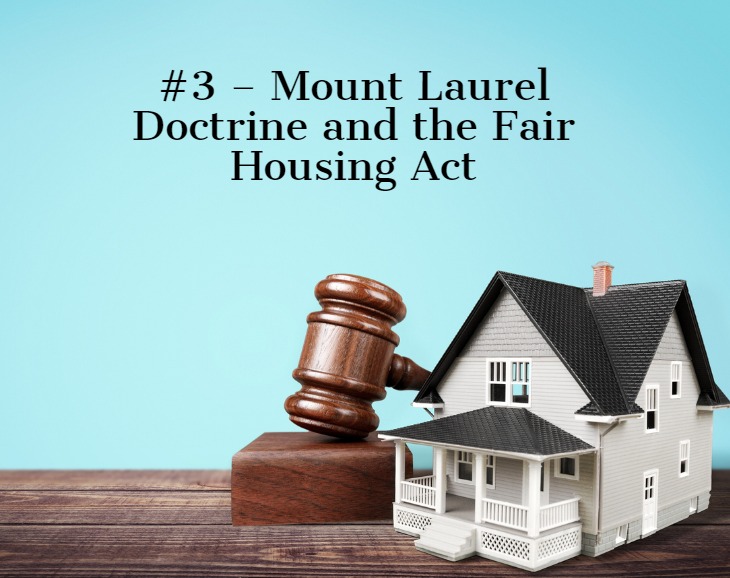#3 Genova Burns’ 30th Anniversary Countdown of the Most Influential Cases, Events and Laws
Mount Laurel Doctrine and the Fair Housing Act
January 13, 2020
The Mount Laurel Doctrine, a New Jersey Supreme Court judicial interpretation of the State Constitution resulting from one primary lawsuit and the appeals of many others, prohibits the local governments from engaging in economic discrimination against the poor through the exercise of powers land use laws. These cases are considered among the most significant civil rights determinations since the United Supreme Court’s 1954 ruling in Brown v. Board of Education.
In its decision, the New Jersey Supreme Court declared land use regulations that result in prevention of affordable housing opportunities for low and middle income families unconstitutional. Its holding created a responsibility for all New Jersey municipalities to provide opportunities for a so-called “fair share” of affordable housing. The Court’s second Mount Laurel opinion deferred to legislative action to determine the appropriate methods to meet its mandate, resulting in the New Jersey Legislature’s 1985 adoption of the Fair Housing Act. The Act, as amended, continues to regulate affordable housing opportunities in New Jersey.
“The impact of the Mount Laurel decisions continues to be felt throughout the state almost five decades after the original decision,” said Jennifer Roselle, Esq., Counsel at Genova Burns LLC. “The decisions and subsequent legislation allow low and middle income families to build lives and take advantage of the opportunities offered in the communities they choose.“
CASE & REGULATORY SUMMARY:
The Mount Laurel Doctrine was a controversial judicial interpretation of the New Jersey Constitution that required municipalities use their zoning statutes in a manner that offered a realistic opportunity for access to and the production of affordable housing for low and moderate income families. Named for the 1975 New Jersey Supreme Court, Southern Burlington County N.A.A.C.P. v. Mount Laurel Township (Mount Laurel I) and its progeny, the Court assessed the constitutionality of zoning ordinances which served to preclude low or moderate income families from obtaining housing in the community. Ruling in the plaintiffs’ favor, the Court ordered Mount Lauren Township to create a plan to create opportunities for poor residents to obtain affordable housing.
Following the legal decision and court opinion in Mount Laurel I, additional lawsuits were filed against other towns and municipalities, with plaintiffs falling into three main classes – lower income persons who actually sought housing and advocacy organizations on their behalf; the New Jersey Public Advocate; and builders who were looking to create developments with affordable housing. These early suits were fraught with difficulty and resulted in only a small trickle of affordable housing.
In 1983, appeals across a number of these cases, including the original Mount Laurel I case, afforded the New Jersey Supreme Court an opportunity to provide reaffirmation and make needed changes and updates to the Mount Laurel Doctrine. Referred to as the Mount Laurel II decision, the Court created a number of requirements to meet the so-called “fair share” obligations.
As a result of Mount Laurel II, and partly due to the Court’s deference to legislative action, the state legislature created and passed the Fair Housing Act. The Fair Housing Act also created the Council on Affordable Housing (COAH), a state-based agency that set the regulatory obligations of each municipality for the number of affordable housing units and how the obligation could be satisfied.
As a result, COAH subsequently created a formula to compute the number of affordable units that each municipality must offer. From there, municipalities were required to develop plans to achieve compliance addressing: application of credits (e.g. filtering, spontaneous rehabilitation, extra credit for rental units); the use of regional contribution agreements (transferring part of one municipality’s obligation to a willing municipality, usually located in an urban center in the same region and related financial compensation); and appropriate local-based zoning regulations for affordable housing.
For some municipalities, participation meant using a formula that might produce a lower obligation than the court would impose and affording it the ability to determine where in the municipality the affordable housing might be built. Some municipalities chose not to participate in COAH's administrative process. While they were vulnerable to lawsuits, they felt that COAH would require them to zone certain land in a manner that would mandate that extra housing be produced. While the Mount Laurel decisions set forth a constitutional obligation for every New Jersey municipality, specifically those in a "growth area," to provide a fair share of its region's housing for low and moderate income families, it set forth no funding source in a state that already has some of the nation's highest property taxes.
Since its creation, the Fair Housing Act has been modified and updated to better function with present-day needs. It was amended in 2008 to create a 2.5% commercial development fee to support affordable housing in municipalities. It also eliminated the Regional Contribution Agreement, which had permitted a municipality to transfer portions of its obligation to another municipality. In 2011, amendments eliminated COAH and gave oversight duties for affordable housing to the New Jersey Department of Community Affairs. In 2012, then-Governor Christie formally abolished COAH under executive order, a move that was subsequently overturned by the Appellate Division of Superior Court, thus restoring COAH.
From 1999- 2015, COAH failed to establish affordable housing quotas and guidelines for municipalities, moving the New Jersey Supreme Court to order the state courts to take over that responsibility. To that end, municipalities submitted draft affordable housing plans to the courts and filed for certification to protect them from lawsuits. As a result, the Cherry Hill-based Fair Share Housing Center involved itself in cases where they felt adequate affordable housing wasn’t provided or planned, filing suit against a number of municipalities statewide. In response, many municipalities have settled cases through agreements that will provide large numbers of affordable housing units for eligible New Jerseyans by 2025.
Tags: Genova Burns LLC • COAH • Fair Housing Act • New Jersey

